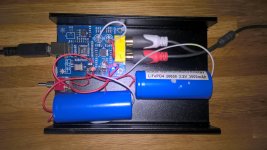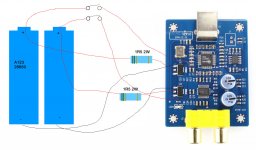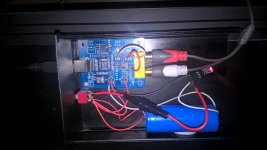The sa9023 does not require a driver for windows.
I have found that a solid polymer type works good as main filter capacitor for the sa9023.
The 5102 has a pair of charge pump capacitors that can be upgraded to film types also.
Thanks.
The driver is for the SA9227, kind of wish I had a SA9023 because so far the driver has been a little finicky, all is fine when it's fine, but there is no unplug and replug if you want to restart it. Works fine on every boot up though for days on end.
The rest of your answer I'll Google about, crazy how a few years of not touching any parts makes you forget what little started to make sense when you did
You could bypass the low pass filter altogether and wire straight from the + side where the coupling caps were to the phono sockets. This is what John Kenny does in his JKDAC32.
I asked him about this and given the datasheet states "Compared with many conventional switched capacitor DAC architectures, the PCM510xA family offers up to 20 dB lower out-of-band noise, reducing EMI and aliasing in downstream amplifiers/ADCs, measured from the traditional 100-kHz OBN measurements to 3 MHz).", he said "In my research & experiments, this DAC sounded better when used with no RC filter on it's output - the noise is obviously low enough to be of no concern to downstream preamplifiers/amplifiers."
I have also tried various dual 3.3v linear power supply options wired directly to the board where the two AMS1117-3.3v regulators sit. This gives significant improvements, but by far the biggest improvement is achieved by powering these two 3.3v circuits by a regulated battery supply.
I would love to build something like the DAC with the separate supplies, but the more stuff I have on desk, the more looks I get at work. So bypassing filters inside the original box would be preferable.
To improve the low end, the first thing I'd look at is the DAC output impedance and amplifier input impedance. The PCM5102 has a relatively high output impedance (100ohms or more from memory) and there may be additional series resistors on the output (the datasheet recommends 470ohm). If the dac is connected directly to a relatively low input impedance amp (10Kohm or so) that would typically impact dynamics and bass weight/focus. I'd try a buffer stage between the Dac output and amplifier input.
The amp seems to have 10kOhm input impedance indeed.
So ill see about a buffer stage and what space I need.
Thank you both,
Daniel
Thanks.
The driver is for the SA9227, kind of wish I had a SA9023 because so far the driver has been a little finicky, all is fine when it's fine, but there is no unplug and replug if you want to restart it. Works fine on every boot up though for days on end.
The chip defaults to class 2 mode if it already has power before negotiating with host ( which is why it works on boot up) if you unplug while th pc is on,then it goes into class 1 mode. The only way round this is to use a splitter cable so you can disconnect/reconnect with 5v power intact.
The chip defaults to class 2 mode if it already has power before negotiating with host ( which is why it works on boot up) if you unplug while th pc is on,then it goes into class 1 mode. The only way round this is to use a splitter cable so you can disconnect/reconnect with 5v power intact.
The cable cph2000 linked should do that if I'm right that red auxiliary plug has no data and only power, then I should be able to unplug and replug black USB A on PC?
https://www.amazon.com/C2G-Cables-28108-Y-Cable-Black/dp/B0013LSFJI
My appologies, I had glossed over the 9227 part...

The cable cph2000 linked should do that if I'm right that red auxiliary plug has no data and only power, then I should be able to unplug and replug black USB A on PC?
https://www.amazon.com/C2G-Cables-28108-Y-Cable-Black/dp/B0013LSFJI
Yes, works fine, so that's one big improvement to no longer need to reboot to be able to use it after replugging (every few days it would vanish, likely has to do with the machine in the shop that makes our UPS' beep when the spindle brakes)
Thanks for pointing out the two modes and how to make the DAC happy!
Here is latest incarnation of the DAC in a new 150x105x55mm case. Having tested various linear PSUs (LT3042/ADM7150 etc), I have now gone down the 3.2v 26650 LiFePO4 battery route. These batteries have an extremely low resistance and a stable output which is perfect for feeding this dac.
The onboard AMS117 regulators have had their 3.3v supply to the board cut and instead provide a float/trickle charge of 3.3v to the batteries through a resistor to limit current to about 500ma. The batteries then feed the board directly via a dual pole switch (no regulators etc). In addition because the batteries are able to supply current so fast all the capacitors on the supply rails have been removed (even the bypass caps). There is debate and argument on various forums about the merit of this but the sound quality is greatly improved by doing so. In addition the low pass filter and DC blocking caps have been removed and the phono sockets wired directly to the DAC analogue out. Only C24 & C20 remain in place, C14,C15,C16,C16,C18,C19,C21,C22,C23,C25, R20,R21,R24 & R25 have all been removed.
I have tried various things with this board, but this by far provides the best sound quality by some margin - bass, depth, vocal space, top end.
The onboard AMS117 regulators have had their 3.3v supply to the board cut and instead provide a float/trickle charge of 3.3v to the batteries through a resistor to limit current to about 500ma. The batteries then feed the board directly via a dual pole switch (no regulators etc). In addition because the batteries are able to supply current so fast all the capacitors on the supply rails have been removed (even the bypass caps). There is debate and argument on various forums about the merit of this but the sound quality is greatly improved by doing so. In addition the low pass filter and DC blocking caps have been removed and the phono sockets wired directly to the DAC analogue out. Only C24 & C20 remain in place, C14,C15,C16,C16,C18,C19,C21,C22,C23,C25, R20,R21,R24 & R25 have all been removed.
I have tried various things with this board, but this by far provides the best sound quality by some margin - bass, depth, vocal space, top end.
Attachments
Will you be so kind to draw all that has been done, with the correct values and connections.
Maybe some links if somewhere has already explained everything.
Thank you.
Please see attached for the power arrangement (NB the regulators have had their 3.3v supply to the board cut)
Attachments
Last edited:
In addition because the batteries are able to supply current so fast all the capacitors on the supply rails have been removed (even the bypass caps). There is debate and argument on various forums about the merit of this but the sound quality is greatly improved by doing so.
You do need HF decoupling for the DAC, and there is significant distance between the battery terminals and the DAC IC, so this means significant inductance. Retaining the low value bypass caps right beside the DAC pins will result in better technical performance (if not your subjective preferences).
Also, do the regs remain in circuit during use? If so they will still be injecting noise during playback (albeit the 1.5r series resistor and low ESR of the battery will reduce this). If the regs remain in circuit it's hard to see the technical advantage of the batteries vs low ESR caps (again, subjective differences may vary).
Also, do the regs remain in circuit during use?
Yes they do, to provide a float charge to the battery, but the sound does not change if they are disconnected which leads me to think that either the battery absorbs the noise or it never reaches the DAC. The only way to appreciate this is to try it.
Last edited:
Hi guy's!
Have a big problem with the DA3! Installed the driver and plugged the dac in, played standard flac - Ok, played a 24/96 flac - ok, then i tried a 24/192 flac - silence? OK, back to standard flac again - silent, unplugged dac, plugged back in, now: "unknown usb device, device descriptor failed, code 43", since then it's been dead? the blue led is on, but no matter what i do, it is not recognised by windows? Tried everything i have been adviced to do, even got a driver from the seller via email - still not recognised?
Did i break it when i played a 24/192 file, witch it is supposed to handle (32/384)? I don't now much about these things, but i looked at the data sheet of SA9227, and there is a reset pin, to shift it to normal mode, did it possibly end up in the "wrong mode" when i played that file? Or - is it simply defective?
Even my seller has no idea, we are talking about replacing it, but i'd rather fix it if it is possible...
Anybody have any idea?
Have a big problem with the DA3! Installed the driver and plugged the dac in, played standard flac - Ok, played a 24/96 flac - ok, then i tried a 24/192 flac - silence? OK, back to standard flac again - silent, unplugged dac, plugged back in, now: "unknown usb device, device descriptor failed, code 43", since then it's been dead? the blue led is on, but no matter what i do, it is not recognised by windows? Tried everything i have been adviced to do, even got a driver from the seller via email - still not recognised?
Did i break it when i played a 24/192 file, witch it is supposed to handle (32/384)? I don't now much about these things, but i looked at the data sheet of SA9227, and there is a reset pin, to shift it to normal mode, did it possibly end up in the "wrong mode" when i played that file? Or - is it simply defective?
Even my seller has no idea, we are talking about replacing it, but i'd rather fix it if it is possible...
Anybody have any idea?
Excelent!
Happy for you, does it sound any good?
For me it ended with a return and refund, my loss $3, in total, but OK i learned loads about USB audio...
Got a cheap Chines "PCM2704" based card, $6. Using it as a USB ---> coax bridge to my old LiTe DAC-AH, limited to 16/44.1 with that config, but it sounds realy "sweet"... Getting a DAC/AMP, later next year - something like SMSL M6, xduoo x5... i.e the price segment $100-150... or whatever things are out there next summer or so....
BTW - You used an other port, faster? Not a USB 3.0? Cos i only have USB2.0 available....
Best of luck!
Cheer's/T.
Happy for you, does it sound any good?
For me it ended with a return and refund, my loss $3, in total, but OK i learned loads about USB audio...
Got a cheap Chines "PCM2704" based card, $6. Using it as a USB ---> coax bridge to my old LiTe DAC-AH, limited to 16/44.1 with that config, but it sounds realy "sweet"... Getting a DAC/AMP, later next year - something like SMSL M6, xduoo x5... i.e the price segment $100-150... or whatever things are out there next summer or so....
BTW - You used an other port, faster? Not a USB 3.0? Cos i only have USB2.0 available....
Best of luck!
Cheer's/T.
Here is latest incarnation of the DAC in a 150x105x55mm case. The 3.2v 26650 LiFePO4 battery provides an extremely stable pure DC voltage with no AC ripple.
Having removed all the power bypass capacitors around the DAC, I have now removed all the caps around the SA9227 receiver chip, eprom and USB clock. This has reduced noise, improved timing even further and as a result sound quality has improved no end.
The onboard AMS117 regulators have been removed as has the onboard LED. There is a separate 5v to 3.3v power supply float charging a single battery which feeds the USB and DAC circuits. Only C13, C20, C24, C28 & C29 remain on the board. The float charge to the battery is protected by a 250ma fuse and both the charge supply and the supply between the battery and the board share a dual pole switch (so the battery can be isolated when the device is switched off). As the battery keep its charge so well there is no need to constantly trickle charge and any recharging only takes place when the device is being used.
Having removed all the power bypass capacitors around the DAC, I have now removed all the caps around the SA9227 receiver chip, eprom and USB clock. This has reduced noise, improved timing even further and as a result sound quality has improved no end.
The onboard AMS117 regulators have been removed as has the onboard LED. There is a separate 5v to 3.3v power supply float charging a single battery which feeds the USB and DAC circuits. Only C13, C20, C24, C28 & C29 remain on the board. The float charge to the battery is protected by a 250ma fuse and both the charge supply and the supply between the battery and the board share a dual pole switch (so the battery can be isolated when the device is switched off). As the battery keep its charge so well there is no need to constantly trickle charge and any recharging only takes place when the device is being used.
Attachments
Hi, what does it mean: "There is a separate 5v to 3.3v power suppy"? Is this a separate ams1117?Here is latest incarnation of the DAC in a 150x105x55mm case. The 3.2v 26650 LiFePO4 battery provides an extremely stable pure DC voltage with no AC ripple.
Having removed all the power bypass capacitors around the DAC, I have now removed all the caps around the SA9227 receiver chip, eprom and USB clock. This has reduced noise, improved timing even further and as a result sound quality has improved no end.
The onboard AMS117 regulators have been removed as has the onboard LED. There is a separate 5v to 3.3v power supply float charging a single battery which feeds the USB and DAC circuits. Only C13, C20, C24, C28 & C29 remain on the board. The float charge to the battery is protected by a 250ma fuse and both the charge supply and the supply between the battery and the board share a dual pole switch (so the battery can be isolated when the device is switched off). As the battery keep its charge so well there is no need to constantly trickle charge and any recharging only takes place when the device is being used.
Might find this useful, compared both and the TDA1387.
Impressions: USB DAC: TDA1387 NOS vs PCM5102A Delta-Sigma
Impressions: USB DAC: TDA1387 NOS vs PCM5102A Delta-Sigma
Hi, what does it mean: "There is a separate 5v to 3.3v power suppy"? Is this a separate ams1117?
Yes, there is a separate AMS1117 board which provides the float charge protected by a 250ma fuse. The switch disconnects the battery and the charger so the battery is isolated when not in use. It does not lose charge so works well.
- Status
- This old topic is closed. If you want to reopen this topic, contact a moderator using the "Report Post" button.
- Home
- Source & Line
- Digital Line Level
- Cheap SA9027 + ES9023 (or PCM5102) DAC, anyone try?



